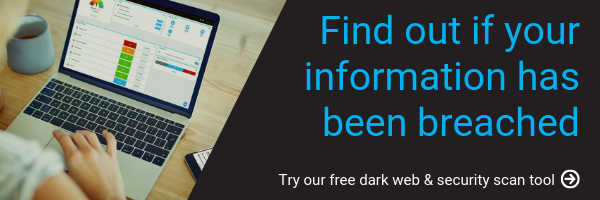Understanding how a hacker can use your data is useful, especially if you want to know how to protect yourself online. Do you know what happens if your personal information is leaked? Or how to check if your information has already been leaked in breaches from sites like Netflix, MyFitnessPal or Marriott? DynaRisk’s free dark web scanning tool can help.
Understanding how a hacker can use your data is useful, especially if you want to know how to protect yourself online. Do you know what happens if your personal information is leaked? Or how to check if your information has already been leaked in breaches from sites like Netflix, MyFitnessPal or Marriott? DynaRisk’s free dark web scanning tool can help.
Data breaches are often a mixed bag in terms of what information is stolen; last month DynaRisk recovered 47,857,305 leaked data records made up of email addresses, usernames, passwords, full names, phone numbers, home addresses, dates of birth, job titles and more. In this post we tell you how your information can be used to target you, and how you can use our tools to better protect yourself online.
Your username or email address
With just a username or email address, hackers can attempt to gain access to your accounts using password cracking techniques. Password cracking is commonly used by hackers to gain unauthorized access using common passwords or algorithms that guess passwords. If a hacker successfully cracks your password they may then use credential stuffing tools which enter the email/username/password combination into hundreds of popular websites to try and gain access. So if you have used the same password on a number of sites, you could end up having multiple accounts taken over.
Use a unique password for every site, account and device – password managers like LastPass can help you to stay on top of things if you’re worried about remembering everything. LastPass can also be used to generate strong passwords too.
Some hackers may also use your email address to send phishing scams in an attempt to defraud you out of money. The TV Licensing scam is a well known example – so much so that they have included information on how to avoid being scammed on their website.
Your phone number
Hackers can use your phone number to carry out targeted social engineering scams and instances of people being defrauded out of thousands of pounds have been reported in the media numerous times over the past year.
It’s incredibly important to exercise caution whenever you get a call out of the blue that involves paying or moving money. Fraudsters have been known to disguise their caller ID using bank names, even quoting recent payments as proof of legitimacy – therefore it’s important to remember some golden rules. Your bank will never ask you to move money to a safe account, quoting a recent payment is NOT proof that you are talking with a genuine representative from your bank and if you receive a call asking for payment, or asking you to transfer your money, check the phone number is legitimate. Alternatively, ask if you can call them back and only call the company’s official telephone number that you have double checked on their website.
Your job title
With your name and job title a fraudster may be able to locate you on LinkedIn and as a result, attempt to defraud you. LinkedIn scams are becoming increasingly popular as it’s an easy way to identify people in high-earning jobs. Scams can involve sextortion – bribing somebody by threatening to release sensitive information of a sexual nature – or even sending fake job offers or meeting requests containing malware, ransomware and spyware.
Your WiFi password
Anyone with your WiFi password can gain access to all connected computers and devices within your network. This can be used to do anything – from copying your data to monitoring your usage and websites you visit. When you receive a wireless router, the password should be changed immediately. You should also update the software as often as required to make sure it’s free of bugs.
Worried your information might have been stolen? Use our free data breach scanning tool
Try our free dark web and security scanning tool to see if your information has ever been leaked online. It’s simple – enter your email address and we’ll check it against our database of stolen records. If we find a match, we’ll let you know – 60% of people who scan their email address discover it was compromised in a breach, and as a result were able to take action to secure all their accounts.

